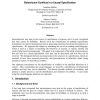Free Online Productivity Tools
i2Speak
i2Symbol
i2OCR
iTex2Img
iWeb2Print
iWeb2Shot
i2Type
iPdf2Split
iPdf2Merge
i2Bopomofo
i2Arabic
i2Style
i2Image
i2PDF
iLatex2Rtf
Sci2ools
ASE
2000
2000
Behavioural Conflicts in a Causal Specification
Inconsistencies may arise in the course of specification of systems, and it is now recognised that they cannot be forbidden. Recent work has concentrated on enabling requirements descriptions to tolerate inconsistency and on proposing notations that permit inconsistency in specifications. We approach the subject by examining the use of an existing causal language, which is used as a means of specifying the behaviour of systems, to specify, identify and resolve behavioural inconsistencies. This paper is an exploration of the kinds of inconsistency that can arise in a causal specification, how they can be discovered and how they can be resolved. We distinguish between inconsistencies in the structure of a specification, which are assumed to have been removed previously, and inconsistencies in behaviour which, being dynamic in nature, we describe as conflicts. Our approach concentrates on the identification of conflicts in the specified behaviour of a system. After summarising the causal...
| Added | 17 Dec 2010 |
| Updated | 17 Dec 2010 |
| Type | Journal |
| Year | 2000 |
| Where | ASE |
| Authors | Jonathan D. Moffett, Andrew Vickers |
Comments (0)

